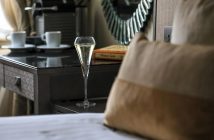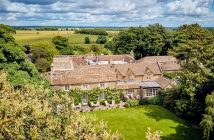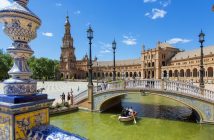This was the first time I had experienced a personal butler. It was ever so slightly odd, but then, much of what we experienced at the Vaamika Island Resort was far from the norm. Founded by Klaus Schleusener, an eccentric who purchased the island mid-way up India’s most south-western state of Kerala in 1998, the island was transformed with the addition of five large villas. It opened to paying guests as Green Lagoon Resort in 2007 and was sold to a development company in 2011, changing its name to Vaamika. It is now undergoing renovation with the addition of three new cottages and a spa island featuring a special Kettuvalam (or Keralan houseboat) altered to house yoga classes and spa treatments, all due to be ready during 2013.
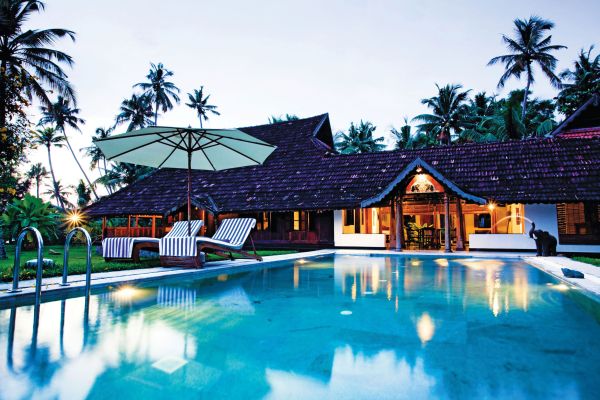
We began our experience with Vaamika by way of a SunRay speedboat – a sexy, cream and tan leather beast that motored us to the island from the mainland just as the sun was waning; our driver twisting and navigating the way through thick pond lilies and marsh weeds. Around the first turn of the island our resting spot High Noon came into view, a 200-year old villa brought to the island and painfully and slowly reconstructed bit by bit, fronted by a huge lakefront infinity pool.
Upon debarkation, we were greeted by cream suited young staff members, wielding large floral leis and a cream and red beaded parasol to protect us from the sun. We walked along pathways dotted with lanterns and over painted bridges for five minutes until arriving at the outstandingly luxurious villa, complete with two large bedrooms, a vast outdoor tiled bathroom, a monstrously huge flat screen TV, outdoor lounge space, private massage room and expansive pool looking out to the lagoon. It was then we were presented with a mobile and informed that Nibin, our butler, would be at our service at the press of a button.
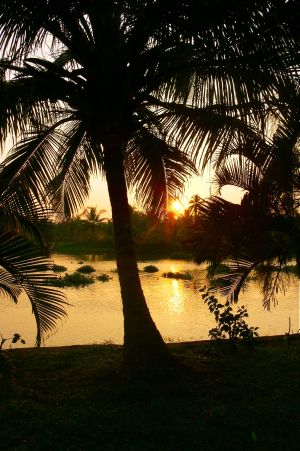 Vaamika prides itself on being extremely private. Meals are served at your villa – or within the grounds if you fancy it – and there is no restaurant on-site where you must converse with other guests. In fact, other than the conversations with Nibin (or Mahi, our butler on day two), and a couple with manager Albert, we barely saw another soul in nearly 48 hours on the island. Sure, there was the time our neighbours unwittingly wandered into our villa thinking it was the museum – oh, there’s also a private museum – and we felt we must make conversation, but other than that it was a world unto our own.
Vaamika prides itself on being extremely private. Meals are served at your villa – or within the grounds if you fancy it – and there is no restaurant on-site where you must converse with other guests. In fact, other than the conversations with Nibin (or Mahi, our butler on day two), and a couple with manager Albert, we barely saw another soul in nearly 48 hours on the island. Sure, there was the time our neighbours unwittingly wandered into our villa thinking it was the museum – oh, there’s also a private museum – and we felt we must make conversation, but other than that it was a world unto our own.
If guests wish to depart from their solitary space, the island runs historical tours to nearby Fort Cochin and walks through villages on other islands to meet locals and discuss the culture and history of the area. Guests can also rent the speed boat by the hour to head to nearby Allepey or Lake Kumarakom for lunches or dinners off the island.
We chose to simply take in the splendour and rare treat of such solitude – a fact many may consider all the more important if they’ve ever experienced the pure chaos of the rest of India. When necessary, we’d give Nibin a call and have beer delivered or inform him what time we’d like our meals, the latter of which never failed to impress with both their size and flavour. Every one featured at least seven dishes of the chef’s choice – the standouts of which were the spicy, crispy-skinned fish with cucumber salad, Keralan prawns with a guava dressing and the odd but mouth-watering pineapple and yoghurt curry. We soon learned to not finish every bite for fear of explosion.
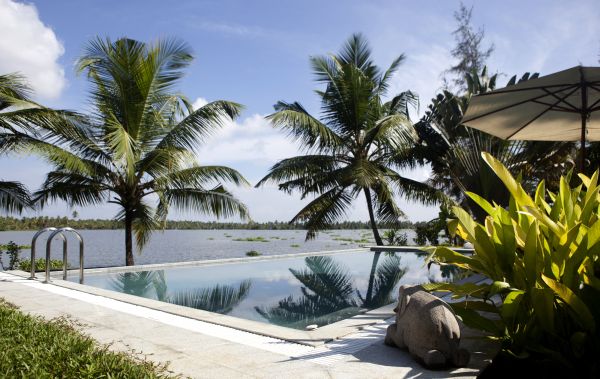
One evening, I decided to visit the on-site museum with manager Albert. The idea of a private museum on a private island seemed too good to miss and I was amazed at its contents. Designed by German architect Hans-Peter Gresser (a friend of Klaus, the original owner) the museum was built in a half-Mandala shape, with minimalist red and white walls. Inside was a collection of Kaavada (pronounced: cowardi), which are stone or wood carved rectangular blocks worn on the shoulders of people taking pilgrimage (most often) to the Palani temple in Tamil Nadu. Pilgrims dance with these on their shoulders while making prayers to Hindu god Lord Subramanya. Klaus bought the figurines over many years from various parts of Kerala and Tamil Nadu, creating this exclusive collection. The museum also features wood, metal and coconut shell ash boxes – which were used for storing relatives’ remains – some of which are more than 500 years old. It is an incredible find and well worth visiting when at Vaamika.
The resort is a retreat, perfect for couples or families wishing to really get away from it all during a stay in India; really, it would be hard to find a quieter place in a country filled with constant colour, noise and people. While the renovations were a slight distraction to our stay, I have no doubt that once those are fully completed, it will be a resort like no other. Just make sure you’ve got a good book to hand to fill the quiet hours – and a penchant for having a butler.

